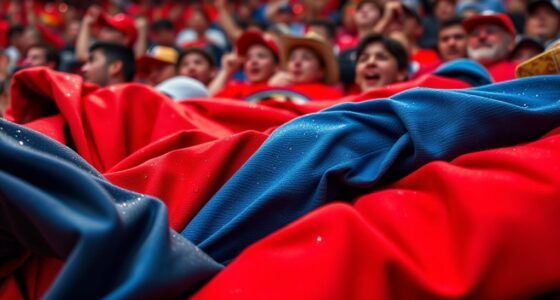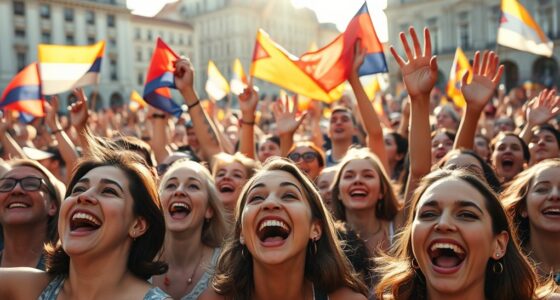Waves and flash mobs show different types of crowd dynamics experiments—waves are spontaneous, ripple-like movements triggered by shared energy and cues, while flash mobs are planned gatherings coordinated via social media and rehearsals. Researchers study these behaviors using motion sensors, video analysis, and virtual simulations to understand how social cues and environmental factors influence group actions. Exploring these phenomena reveals fascinating insights into human collective behavior—keep exploring to see what influences crowd synchronicity.
Key Takeaways
- Waves are sequential, ripple-like crowd movements spreading gradually, while flash mobs involve sudden, organized mass gatherings.
- Waves typically occur spontaneously or semi-organized, driven by social cues and emotional contagion over time.
- Flash mobs are planned in advance via social media, emphasizing coordination and rapid collective action.
- Crowd dynamics experiments utilize motion sensors, video analysis, and virtual simulations to study movement patterns of both phenomena.
- Understanding differences in formation, timing, and triggers helps optimize crowd management and event planning strategies.
The Nature of Coordinated Movements in Crowd Events

Coordinated movements in crowd events often appear seamless, but they rely on a complex blend of planning, communication, and social cues. Musical synchronization plays a essential role, as participants often match their actions to a shared rhythm or beat, creating a unified flow. This synchronization fosters a sense of connection, making individuals feel part of something larger. Emotional contagion also influences these movements, as feelings like excitement or anticipation spread quickly through the crowd. When you see or hear others moving in harmony, your emotions align, encouraging you to join in without needing explicit instructions. This collective emotional state amplifies coordination, enabling large groups to act as a cohesive unit. Additionally, understanding relationships and personality dynamics can help explain how social cues and emotional contagion drive crowd cohesion. Ultimately, these elements combine to produce the fluid, coordinated movements seen in crowd events.
Factors Influencing the Formation of Waves and Flash Mobs
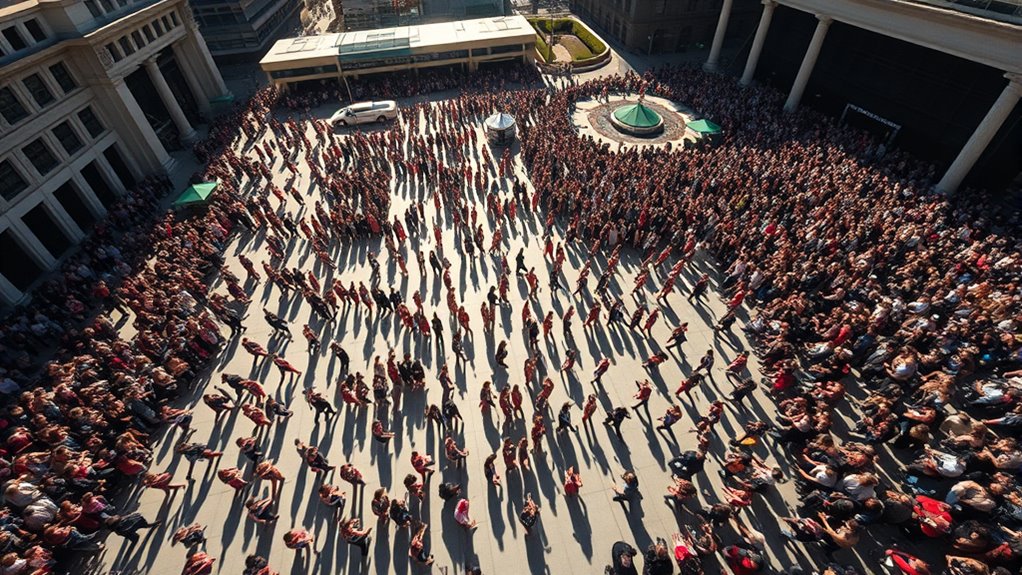
The formation of waves and flash mobs is heavily influenced by social cues, technological connectivity, and environmental factors. Your group psychology plays a pivotal role, as individuals tend to follow cues from others, creating a sense of shared purpose. Environmental triggers, like a specific location or moment, can spark spontaneous participation. To understand these influences better, consider:
- The presence of influential leaders or early adopters who set the tone.
- Visual or auditory signals that prompt immediate action.
- The physical environment, such as open spaces or landmarks, facilitating visibility.
- The social context, including current social trends or collective emotions.
- The role of psychological factors that drive individuals to conform and participate in crowd behaviors.
These factors work together, shaping how quickly and cohesively crowds form waves or flash mobs, driven by shared psychological and environmental cues.
Observing Spontaneity Versus Planning in Crowd Behavior
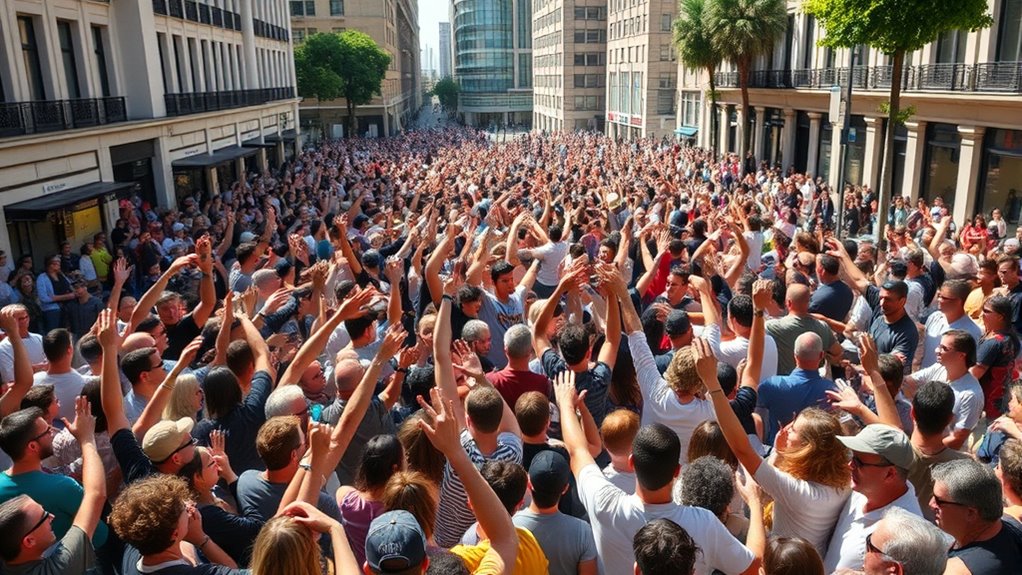
Have you noticed how some crowd actions seem completely spontaneous, while others follow a clear plan? Spontaneous crowd formation often appears unpredictable, driven by immediate emotions or shared excitement. Meanwhile, planned coordination involves deliberate efforts to organize and direct crowd behavior, shaping the overall experience. In some cases, the environment’s layout and designated pathways influence whether a crowd acts spontaneously or in a coordinated manner layout and pathways.
Spontaneous Crowd Formation
Spontaneous crowd formation often appears unpredictable, but it results from subtle cues and shared motivations rather than detailed plans. This spontaneous emergence creates unpredictable patterns that seem to arise suddenly. You might notice these key factors:
- Small triggers, like a shared glance or gesture, spark immediate collective action.
- Common emotions, such as excitement or curiosity, drive rapid group cohesion.
- Environmental cues, like a sudden noise or movement, influence spontaneous responses.
- Social momentum builds quickly as individuals follow perceived cues, reinforcing unpredictable patterns.
- The contrast ratio of environmental factors can also enhance or diminish the visibility of these emergent behaviors.
These elements lead to emergent behaviors that seem to appear out of nowhere, emphasizing the power of subtle signals. Understanding this spontaneous emergence helps explain how crowds form unexpectedly, driven more by shared cues than by deliberate planning.
Planned Coordination Dynamics
While crowd behaviors often seem spontaneous, planned coordination plays an essential role in shaping collective actions. In group psychology, leaders or signals initiate movement, guiding the crowd’s response. Signal propagation allows for efficient communication, ensuring everyone acts in sync. This planning reduces chaos and enhances safety or impact. Consider how flash mobs coordinate through social media, or how event organizers direct large audiences. Their success depends on understanding crowd dynamics and timing signals. The table below highlights key aspects:
| Aspect | Example | Impact |
|---|---|---|
| Planning | Flash mob rehearsals | Smoother execution |
| Signal propagation | Mobile alerts, visual cues | Rapid response |
| Group psychology | Shared purpose, motivation | Increased cohesion |
| Spontaneity overlap | Last-minute improvisation | Flexibility within plans |
| Coordination method | Pre-arranged cues vs. spontaneous | Balance between spontaneity and control |
A crucial factor in effective crowd coordination is behavioral cues, which facilitate seamless interaction between planned signals and spontaneous actions.
The Role of Social Cues and Communication in Crowd Dynamics
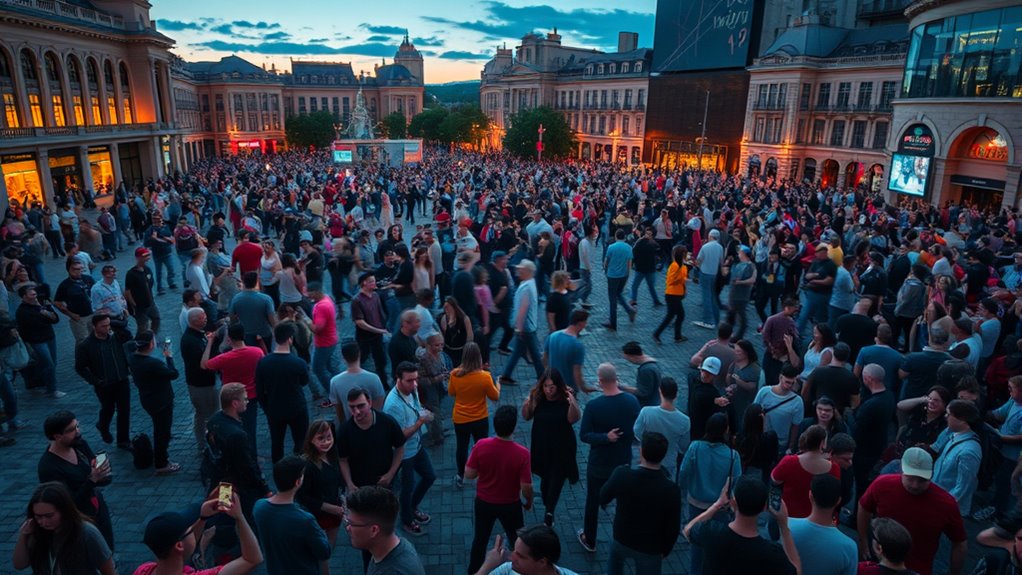
Social cues and communication play a crucial role in shaping how crowds behave during events like waves and flash mobs. These cues help individuals interpret others’ actions and decide when to join in. Without clear communication cues, coordination can falter, leading to disorganized movement. Here are key points to contemplate:
- Social cues like eye contact or gestures signal intentions, guiding crowd responses.
- Verbal and non-verbal communication cues synchronize actions across large groups.
- Visual cues, such as raised arms or synchronized movements, reinforce collective behavior.
- The clarity of communication cues influences the speed and accuracy of crowd coordination.
Experimental Methods Used to Study Crowd Synchronization

Researchers employ a variety of experimental methods to study how crowds achieve synchronization during events like waves and flash mobs. Technological innovations, such as motion sensors, video analysis, and wearable devices, enable precise tracking of individual actions. These tools reveal how psychological motivations—like the desire for social connection or collective identity—drive coordinated behavior. To visualize this, consider the following:
| Method | Purpose | Key Feature |
|---|---|---|
| Motion tracking | Capture movement patterns | High-resolution sensors |
| Controlled experiments | Test social cues in lab settings | Simulated crowd scenarios |
| Virtual simulations | Study crowd response digitally | Immersive VR environments |
This combination of methods helps uncover how technological innovations and psychological motivations work together to produce crowd synchronization. Crowd behavior studies benefit from integrating these approaches to better understand collective actions.
Insights Into Human Collective Behavior From Case Studies
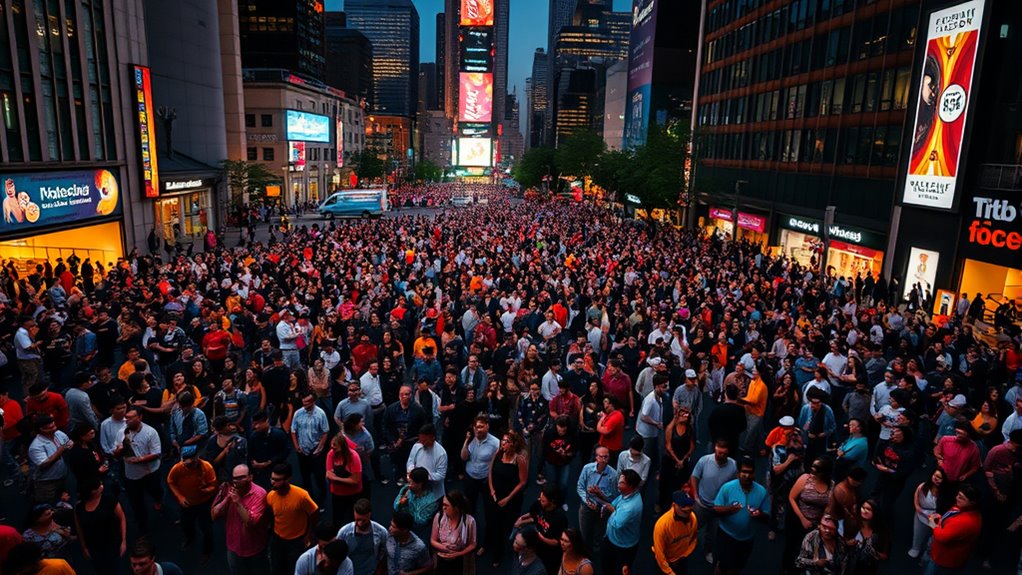
Case studies provide valuable insights into how humans behave collectively during large gatherings or spontaneous events. They reveal patterns that help us understand crowd dynamics through behavioral modeling and psychological triggers. By analyzing real-world examples, you can see how small cues prompt massive actions. For instance, the influence of social influence can significantly alter group behavior, demonstrating how leadership or prominent figures can steer collective actions. These case studies deepen your understanding of collective behavior, showing how psychological triggers and behavioral modeling shape human responses.
Frequently Asked Questions
How Do Individual Motivations Vary Between Waves and Flash Mobs?
You might notice that individual motivations differ between waves and flash mobs. In waves, people often follow group conformity, feeling connected to others and motivated by a shared experience. Conversely, in flash mobs, individuals tend to prioritize personal autonomy, joining for fun or self-expression. Your motivation varies based on the social context, either aligning with the group or acting independently, shaping how you participate in these collective events.
Can Technological Tools Predict the Emergence of Crowd Phenomena Accurately?
Like a weather vane caught in shifting winds, predicting crowd phenomena with technology can be tricky. You rely on predictive modeling to forecast these social storms, but technological limitations often act as foggy glasses, blurring accuracy. While tools can hint at when a wave or flash mob might swell, they can’t capture every gust of human motivation. So, expect some uncertainty, even as technology offers valuable glimpses into crowd behavior.
What Psychological Factors Influence Spontaneous Crowd Synchronization?
You’re curious about what psychological factors influence spontaneous crowd synchronization. Group cohesion plays a key role, as strong bonds make individuals more likely to act in unison. Social conformity also drives this behavior; people tend to follow the crowd to fit in or avoid standing out. When these factors combine, they create an environment where crowd actions happen naturally, leading to synchronized movements without external prompts.
How Do Cultural Differences Affect Crowd Behavior Patterns?
You see that cultural influence shapes how crowds behave, leading to varied patterns across societies. In some cultures, behavioral diversity fosters individual expression within group activities, while others emphasize conformity and collective harmony. These differences impact spontaneous synchronization, making crowd responses more predictable in certain contexts and more dynamic in others. Recognizing these cultural nuances helps you understand why crowd behavior varies globally and how social norms influence collective actions.
Are There Long-Term Psychological Impacts on Participants After Such Events?
You might notice that participating in events like flash mobs or waves can create lasting psychological effects. These experiences often boost group cohesion and foster a sense of belonging. Emotional contagion spreads energy and excitement, which can leave you feeling more connected and motivated afterward. Over time, these shared moments may enhance your social confidence and emotional resilience, shaping how you engage with groups and collective activities in the future.
Conclusion
By now, you’ve seen how crowd behaviors like waves and flash mobs reveal our innate desire to connect and coordinate—think of it as a modern-day dance, much like the ancient rituals. Whether spontaneous or planned, social cues and communication drive these moments. Just remember, even in today’s digital age, the essence of human collective behavior remains timeless, echoing the social fabric woven through centuries—like a well-rehearsed flash mob, it’s all about shared energy and synchronicity.




